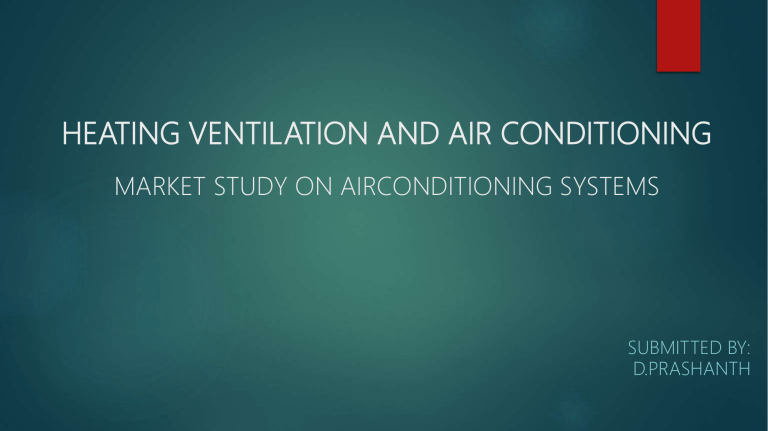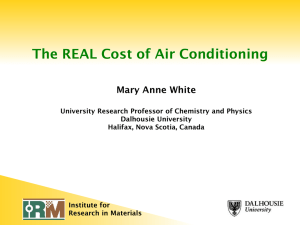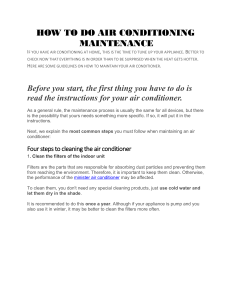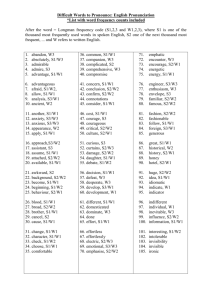
HEATING VENTILATION AND AIR CONDITIONING MARKET STUDY ON AIRCONDITIONING SYSTEMS SUBMITTED BY: D.PRASHANTH CONTENTS INTRODUCTION TERMINOLOGIES CASE STUDY INFERENCE HVAC BYLAWS AIR CONDITIONING Air conditioning is the process of altering the properties of air to create more comfortable conditions, typically with the aim of distributing the conditioned air to an occupied space to improve thermal comfort and indoor air quality . Air conditioning can refer to any form of technology that modifies the condition of air (heating, cooling, dehumidification, cleaning, ventilation, or air movement). HUMAN COMFORT The four atmospheric conditions which affect human comforts are Temperature Humidity Air purity Air Movements An air conditioner controls the above factors for us to achieve human comfort. 90% of the people are comfortable when the air temperature is between 1822°C and the %sat is between 40-65%. AIR HANDLING UNIT An Air Handling Unit or AHU is a central air conditioner station that handles the air that, usually, will be supplied into the buildings by the ventilation ductwork. It is a large metal box containing a blower, heating or cooling elements, filter racks or chambers, humidity & temperature control loops. CHILLER Chiller removes heat from a liquid via vapour-compression or absorption refrigeration cycle. This cooled liquid flows through pipes in a building and passes through coils in air handlers, fan-coil units, or other systems, cooling and usually dehumidifying the air in the building. Chillers are of two kinds: 1. Air Cooled 2. Water Cooled COOLING TOWER The Cooling tower cools the warm water by contacting with unsaturated air. The evaporation of water mainly provides cooling. Water-cooled chillers are normally more energy efficient than air-cooled chillers. TYPES OF AIR CONDITIONING SYSTEMS The choice of which air conditioner system to use depends upon a number of factors including how large the area is to be cooled, the total heat generated inside the enclosed area, etc. An HVAC designer would consider all the related parameters and suggest the system most suitable for your space. Window Air Conditioner Split Air Conditioner Packaged Air Conditioner Central Air Conditioning System Window Air Conditioner Window air conditioner is the most commonly used air conditioner for single rooms. In this air conditioner all the components, namely the compressor, condenser, expansion valve or coil, evaporator and cooling coil are enclosed in a single box. This unit is fitted in a slot made in the wall of the room, or more commonly a window sill. Split Air Conditioner The split air conditioner comprises of two parts: the outdoor unit and the indoor unit. The outdoor unit, fitted outside the room, houses components like the compressor, condenser and expansion valve. The indoor unit comprises the evaporator or cooling coil and the cooling fan. For this unit you don’t have to make any slot in the wall of the room. A split air conditioner can be used to cool one or two rooms. Packaged Air Conditioner This kind of air conditioner is used to cool more than two rooms or a larger space at your home or office. There are two possible arrangements with the package unit. In the first one, all the components, namely the compressor, condenser expansion valve and evaporator are housed in a single box. The cooled air is thrown by the high capacity blower, and it flows through the ducts laid through various rooms. In the second arrangement, the compressor and condenser are housed in one casing. The compressed gas passes through individual units, comprised of the expansion valve and cooling coil, located in various rooms. Central Air Conditioning System Central air conditioning is used for cooling big buildings, houses, offices, entire hotels, gyms, movie theatres, factories etc. If the whole building is to be air conditioned, HVAC engineers find that putting individual units in each of the rooms is very expensive making this a better option. A central air conditioning system is comprised of a huge compressor that has the capacity to produce hundreds of tons of air conditioning. Cooling big halls, malls, huge spaces, galleries etc. is usually only feasible with central conditioning units. CASESTUDY BARZAN ARCADE CASE STUDY KENZ FURNISHING LOCATION: THONDAYAD BYPASS, OPP HILITE MALL NO. OF FLOORS: 5 FUNCTION: FURNITURE AND INTERIOR DECOR TYPE OF AIR CONDITIONING USED – SPLIT AC SYSTEM LOCATION CASE STUDY 10 outdoor units are provided on this facade A series of outdoor units are provided on the exterior side of the building CASE STUDY There is an opening provided for the maintainance and service CASE STUDY Interior units are provide throughout the store CASE STUDY GENERATOR INTERIOR CASE STUDY TYPE OF AIR CONDITIONERS USED: LG L-VOGUE TECHNICAL SPECIFICATIONS: Tonnage Range 2.0TR Cooling(watts) 6350 Compressor Rotary - R22 Power Supply(Volt/Phase/Hz.) 230 / Single / 50 Power Input (Watts) 2000 Running Current(Amps) 9.2 CASE STUDY PERFORMANCE Star Rating Noise Level (Indoor)(dB) 3 40 DIMENSIONS Indoor (mm)(WxHxD) 1090 x 300 x 218 Outdoor (mm)(WxHxD) 870 x 655 x 322 WEIGHT Indoor (Kg) Outdoor (Kg) 13 47 HVAC BYLAWS ASHRAE (AMERICAN SOCIETY FOR HEATING, REFRIGERATION AND AIR CONDITIONINNG ENGINEERING) Air-conditioning and ventilating systems circulating air to more than one floor or floor area shall be provided with dampers designed to close automatically in case of fire and thereby preventing spread of fuel or smoke From fire safety point of view, separate air handling units for the various floors shall be provided so as to avoid the hazards arising from spread of fire and smoke through the air-conditioning ducts. The requirements of air-conditioning ducts shall be in accordance with good practice HVAC BYLAWS DUCT SYSTEM — A continuous passageway for the transmission of air which, in addition to the ducts, may include duct fittings, dampers, plenums, and grilles and diffusers. REFRIGERANT — The fluid used for heat transfer in a refrigerating system, which absorbs heat at a low temperature and low pressure of the fluid Ad rejects heat at a higher temperature and higher pressure of the fluid, usually involving changes of, state of the fluid. HVAC BYLAWS RECIRCULATED AIR — The return air that has been passed through the conditioning apparatus before being re-supplied to the space. PLENUM — An air compartment or chamber to which one or more ducts are connected and which forms part of an air distribution system. The pressure drop and air velocities in the plenum should be low. Generally, the velocity in plenum should not exceed 1.5 to 2.5 m/s. HVAC BYLAWS CHILLERS: Sizing and selecting a chiller is an important aspect in noise control. The following guidelines may be considered for noise control: For rooftop installation of chillers, these may be placed on beams connected on the elevated levels of pillars on correctly chosen vibration isolators. Water cooled chillers have less vibration. However, if air cooled chillers have to be chosen, choose them with fan of less speeds and compressors must be jacketed without compromising their ventilation requirement. If much more silencing is required, plan a silencer on the exhaust of the fans and also an acoustic enclosure around the chillers. Care must be taken for the additional static demand in the fan. HVAC BYLAWS HVAC BYLAWS THANK YOU


